 Previous Page Next Page
Previous Page Next Page
This dialog appears when you click File > Options, or click Options on the Catalog Manager toolbar. It helps you to configure JReport to your preferences and requirements and is divided into the following categories:
Restore Defaults
Restores values of all options to be the default ones.
OK
Applies the changes and closes the dialog.
Cancel
Does not retain the changes and closes the dialog.
Apply
Applies the changes and leaves the dialog open.
Help
Displays the help document about this feature.
The following are details about options of this category.
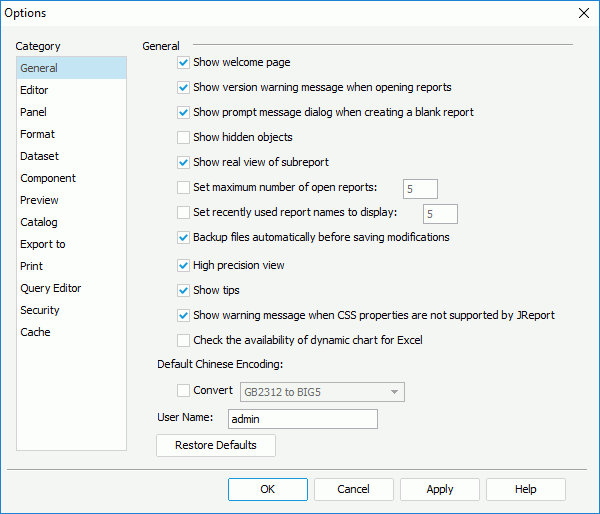
Show welcome page
Specifies whether or not to show the welcome page when you start JReport Designer.
Show version warning message when opening reports
Specifies whether or not to show the version warning message when a report of an earlier version is opened using a higher version. The message warns you that you are about to open a report which belongs to an earlier version, and if you save the report using the current version, you may not be able to open it with the earlier version of JReport Designer again.
Show prompt message dialog when creating a blank report
Specifies whether or not to show the prompt message when a blank report is created. The message prompts you to drag and drop data components from the Components panel and data fields from the Data panel onto the blank report.
Show hidden objects
Specifies whether or not to show objects that are hidden in your report.
Show real view of subreport
Specifies whether or not to show the detailed structure of a subreport in its primary report in design mode.
Set maximum number of open reports
Specifies whether or not to limit the number of the reports that can be opened in JReport Designer. If check, you can set the the maximum number of the reports that can be opened in JReport Designer.
Set recently used report names to display
Specifies whether or not to display names of the recently used reports in the welcome page. If checked, you can set the number of report names that are recently used to display.
Backup files automatically before saving modifications
Specifies whether or not to generate the backup files (.cat.bak and .cls.bak ) of the catalog and report when they are saved.
High Precision View
Specifies the default value for the High Precision View option on the View menu.
Show tips
Specifies whether or not to show the tooltip when you hover the mouse over a property in the Report Inspector or Catalog Manager, or some dialog option.
Show warning message when CSS properties are not supported by JReport
Specifies whether or not to show the warning message when the applied CSS style contains properties that JReport does not support.
Check the availability of dynamic chart for Excel
Specifies to check if a chart can be correctly mapped to a banded object/table when you save the report or export it to Excel.
Default Chinese Encoding
User Name
Specifies the user name which will be applied in cases when a user name value is required, for example, when the special field User Name is referenced in a report.
The following are details about options of this category.

Show status bar
Specifies whether to show the status bar in JReport Designer.
Show ruler
Specifies whether or not to show the horizontal and vertical rulers in the main window of JReport Designer.
Show guidelines
Specifies whether or not to show the guidelines in the main window of the reports.
Show paragraph marks
Specifies whether or not to show the paragraph marks in the design mode of Designer.
Show margins
Specifies whether to show the margins in the design area.
Grids
Specifies the grid properties.
Specifies the display attributes, which can also be set in the Display Attributes dialog.
The following are details about options of this category.
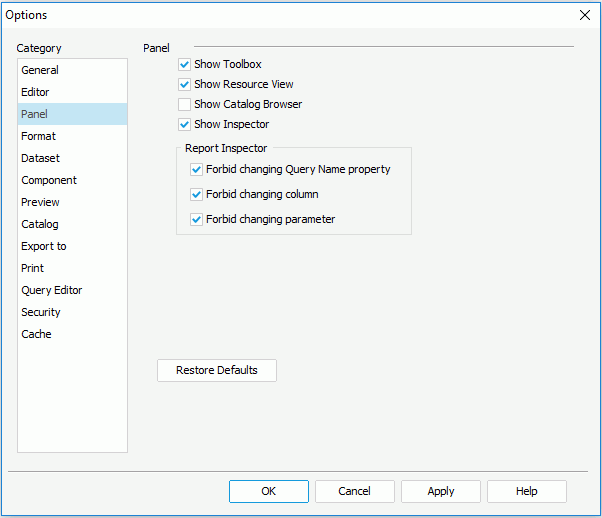 >
>
Show Components
Specifies whether to show the Components panel in Designer.
Show Data
Specifies whether to show the Data panel in Designer.
Show Catalog Manager
Specifies whether to show the Catalog Manager in Designer.
Show Inspector
Specifies whether to show the Inspector panel in Designer.
Report Inspector
The following are details about options of this category. The format properties set here will be applied to all columns in a catalog.
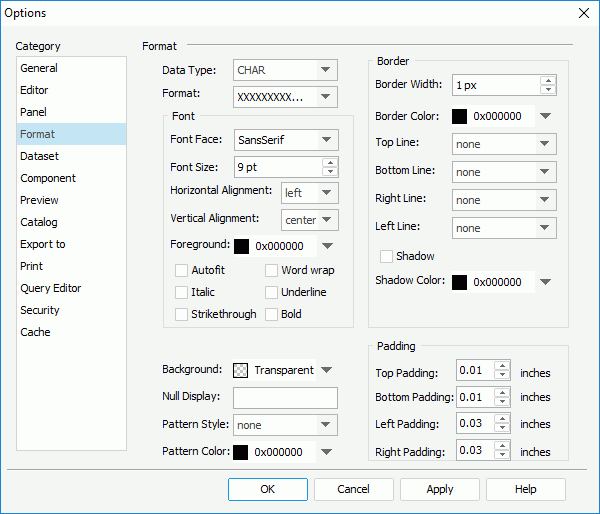
Data Type
Specifies the data type of the columns.
Format
Specifies the format of the columns.
Font
Specifies the font properties of the column contents.
Border
Specifies properties of the column border.
Background
Specifies the color for the background of the columns.
Null Display
If there is no value in a column, JReport will display NULL as default. You can also set what will be displayed when there is no value in the column by inserting the mouse in the Report Inspector and inputting a value.
Pattern Style
Specifies the pattern for the columns.
Pattern Color
Specifies the color to draw the pattern.
Padding
Specifies the spaces between the contents of a column and its borders.
Note: Values specified here will be applied when data columns are added to a catalog. You can adjust the values for each column in the Catalog Manager, or after the columns are added to reports in the Report Inspector.
The following are details about options of this category.
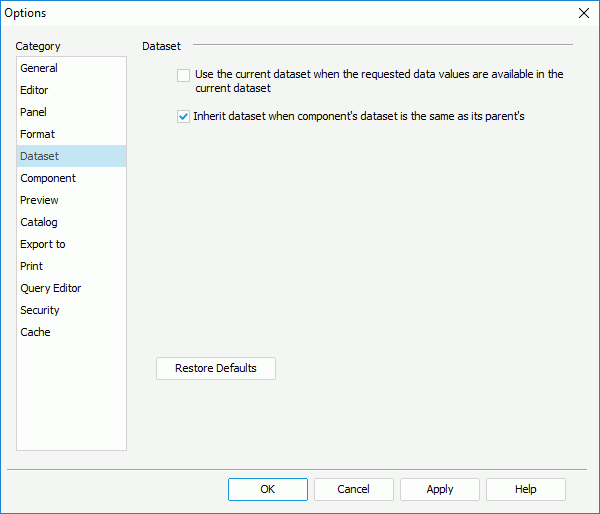
Use the current dataset when the requested data values are available in the current dataset
Specifies whether or not to use the current dataset when the requested data values are available in the current dataset.
Inherit dataset when component's dataset is the same as its parent's
Specifies whether or not to inherit dataset when component's dataset is the same as its parent's dataset.
The following are details about options of this category.
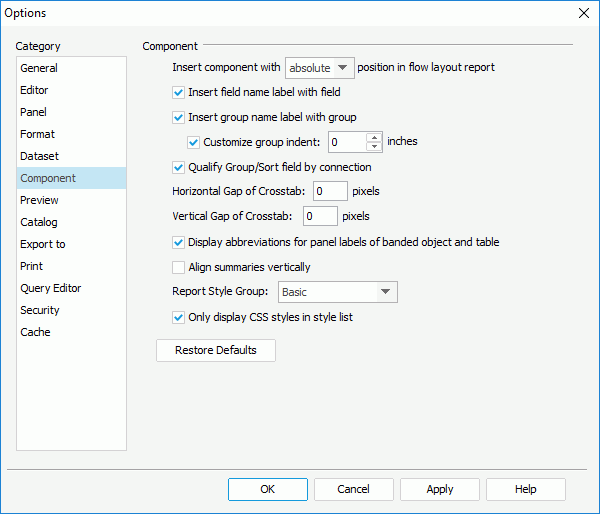
Insert component with static/relative/absolute position in flow layout report
Specifies the default method with which to place components:
See the Position property for more information.
Notes:
Insert field name label with field
Specifies whether or not the fields will be inserted into reports together with their default name labels.
Insert group name label with group
Specifies whether or not the groups will be inserted into reports together with their default name labels.
Specifies whether to customize the indent of groups created via the report wizard. By default, the indent of the groups is 0 inch or centimeter. You can also input a value between 0 and 4 to customize the indent.
If this option is not checked, when you create groups in a report in the report wizard, the groups will be indented according to the width of the group-by fields.
Qualify Group/Sort field by connection
By default, any field added to the catalog in JReport can be used to group and sort. However, you can specify here whether or not a field can be used to group or sort. The qualification information will be stored in the database connection.
Horizontal Gap of Crosstab
Specifies the horizontal gap between two parts of a crosstab, which is split according to the page settings.
Vertical Gap of Crosstab
Specifies the vertical gap between two parts of a crosstab, which is split according to the page settings.
Display abbreviations for panel labels of banded object and table
Specifies whether to display abbreviations for the panel labels of banded object and table in the design area. By turning this off you can see the full name plus the group-by field name.
Specifies whether to align the summaries that are added to tables and banded objects via the report wizard vertically. For tables, this option takes effect only when the summaries are located in detail columns, namely, the table type should be Group Above or Group Left.
Specifies the default selected style for the four types of components when creating/inserting them via the report/component creation wizard: table, crosstab, chart, and banded object. However, when inserting them into a table or banded object which can bind style, the default selected style type will be Inherit Style instead of the value specified by this option.
All CSS styles in the <install_root>\style directory are available in the drop-down list.
Only display CSS styles in style list
Specifies whether to display only the CSS styles in the style list. This is recommended as XSD files have been deprecated.
The following are details about options of this category.
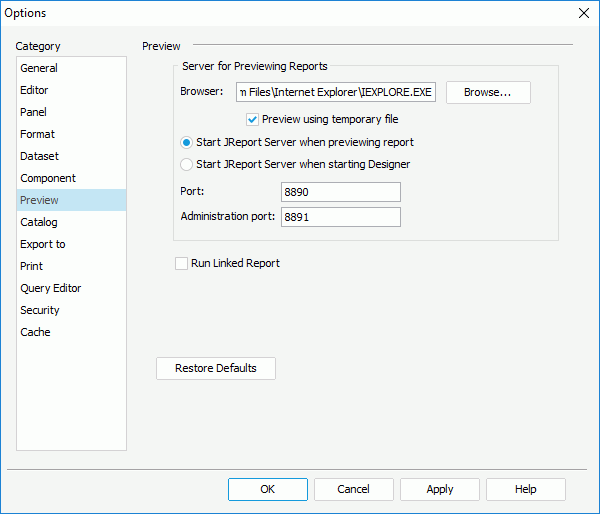
Browser
Specifies the browser for previewing reports.
Preview using temporary file
Specifies whether to preview reports that you design in JReport Designer using a temporary file.
Start JReport Server when previewing report
Specifies whether to start JReport Server at the same time when you preview a report.
Start JReport Server when starting Designer
Specifies whether to start JReport Server when Designer is started.
Port
Specifies the port as the TCP port to which JReport Server listens.
Administration Port
Specifies the port used for remote administration.
Run Linked Report
Specifies whether or not to generate the linked reports (not including the detail reports) when viewing the primary reports in JReport Designer or previewing the primary reports in all formats except for Web Report Result and Page Report Result. Generating linked reports at the same time, especially when the linked reports contain a large amount of data, will cause performance issue.
The following are details about options of this category.

Forbid editing data object properties
By default, you are not permitted to change the data property value in the Catalog Manager. Here you can allow editing object property values of data.
Show warning message when modifying formulas
Specifies whether or not to show warning message when the formulas are modified. The message warns you that modifying a certain formula may impact other reports using the same formula.
Warning Level
Specifies the warning level from the following three options:
Specifies whether or not, and how to sort items in the resource tree. The sort function only applies to resources belonging to the same parent node and of the same type. Real objects in the resource tree instead of logic folder nodes can be sorted.
Merge Catalog Options
Specifies the checking level of merging catalogs when you use Save To to save a report to a directory where a catalog already with the same name exists.
Use cached query result
To use cached query result, in the Catalog Manager, right-click on the query (or imported SQL files, stored procedures and UDSs which function as queries) of your report, and choose Create Cached Query Result, then specify the file name with or without an extension and the folder where you want to save the result file. After which, when you view the report, a dialog will be displayed for you to choose the data file with which to get data for the report instead of using the database to get data for the report.
The options of this category are divided into three sub tabs: HTML, E-mail and Fax.
Layout Precision
Opens the Advanced Export Settings dialog to customize the layout precision for each export format.
Specifies the preferences for exporting the report results to HTML.

Chart
By default, JReport Designer will not display charts in HTML.
File
Specifies whether to convert the report into a single or multiple files.
Use HTML data table
Specifies whether the table and crosstab components will be output as table objects in the HTML format result.
Section 508 compliant output
If checked, the accessibility attributes defined for the report elements via the Report Inspector will be exported to the HTML format report result which is Section 508 compliant. See Accessibility for more information.
When Section 508 Compliant Output is checked, the Use HTML Data Table and Relative Font Size options will be checked and disabled. The output will be Section 508 compliant including HTML data table, accessible attributes, and relative font feature.
Absolute font size
Specifies whether to generate the report result using an absolute font size, which means the font size is fixed and cannot be adjusted according to the font size settings in the web browser.
Relative font size
Specifies whether to generate the report result using a relative font size, which means the font size can be adjusted according to the font size settings in the web browser.
Specifies the preference for exporting the report results to E-mail.
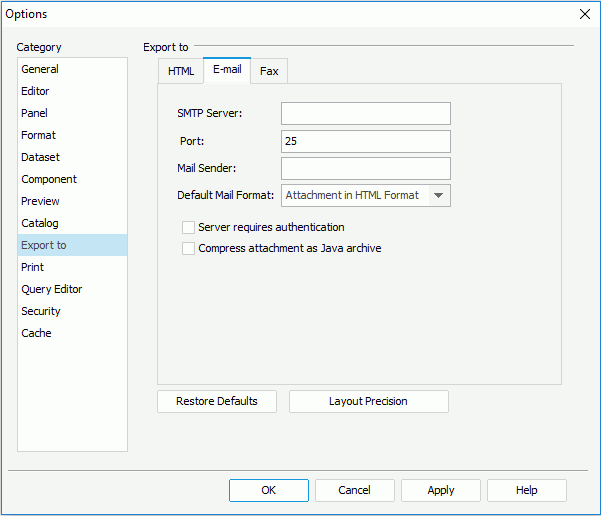
SMTP Server
Specifies the numeric or named host of the machine where the e-mail server is located.
Port
Specifies the port where the e-mail server runs.
Mail Sender
Specifies the address of the e-mail sender. You must specify an address and make sure that the format of the specified address is valid.
Default Mail Format
Specifies the format with which to send the report result.
Server requires authentication
This option must be checked if an SMTP Server requires authentication.
Compress Attachment as Java Archive
Specifies whether or not to compress the mail attachment as Java Archive.
Specifies the preference for exporting the report result to fax. You can specify to export the report result either via a fax machine or a fax server.
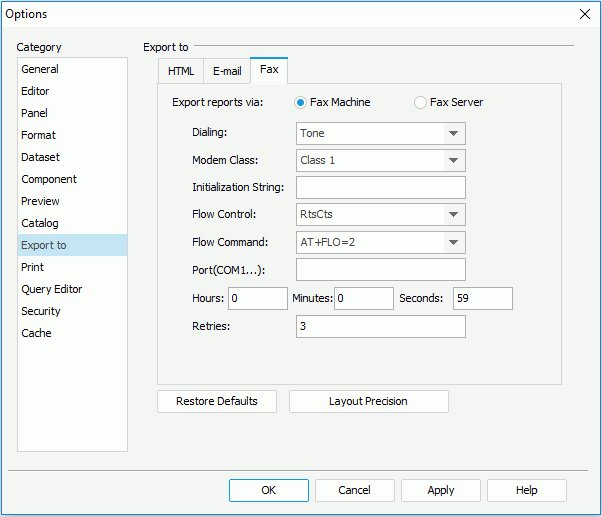
Fax Machine
Specifies to export the report result via a fax machine.
Specifying flow control can help the compressing data function of the modem function better. Using the RtsCts mode is recommended.
Fax Server
Specifies to export the report result via a fax server.
Note: For Hylafax Server the value should not be larger than 59 seconds. It is a limitation of Hylafax Server.
The followings are details about options of this category.
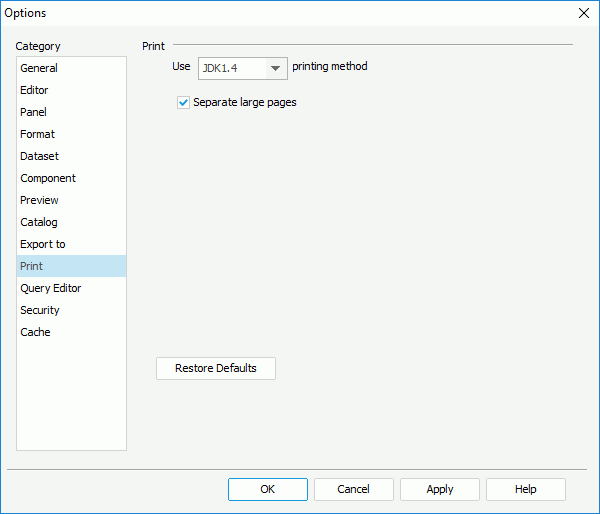
Use JDK1.1/JDK1.2/JDK1.4 printing method
Specifies the printing method to print reports.
Separate large pages
Specifies whether or not to separate large pages during printing. When you print a report with a report page size which is larger than the print paper size, the report will be printed in multiple pages serially. That is, JReport will automatically separate a large page of a report.
The following are details about options of this category.

Auto join
Specifies the options for auto joins.
Pre-join
Specifies the default settings for pre-joins.
Preview Result Set
Specifies the default settings for previewing a result set.
Additional Options
Specifies the additional options.
For example, Table A has three values: A, B and C and Table B has three values: 1, 2 and 3. Value A matches value 1, value B matches value 2, and so on. This is a specific match.
A Cartesian product would have value A matching with 1, 2 and 3, and value B matching with 1, 2 and 3, and so on. Depending on the data values Cartesian products can produce large datasets since each record in Table A matches every record in Table B.
The following are details about options of this category, with which you can set one or more user accounts to use JReport Designer.
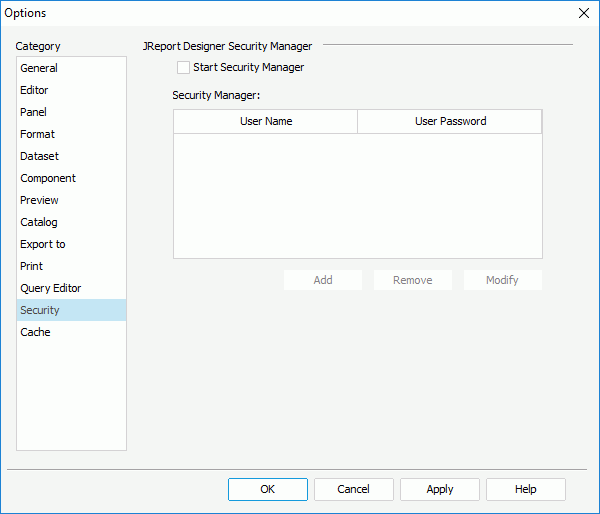
Start Security Manager
Specifies whether to enable this feature or not. For the first time you check this checkbox, you are prompted to create a user account in the Report Register dialog:
Security Manager
Lists all the user accounts.
The following are details about options of this category, with which you can customize the image cache in JReport Designer.

Cache images
Specifies whether or not to enable image cache.